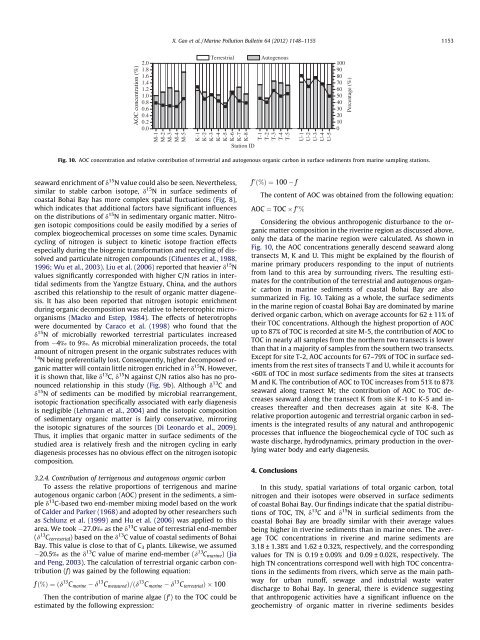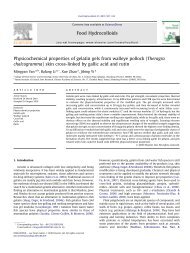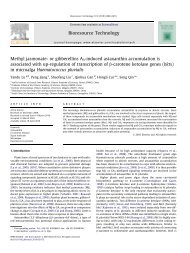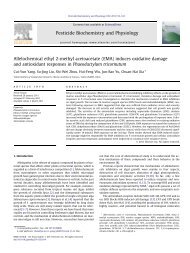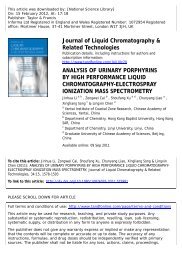seaward enrichment <strong>of</strong> d 15 N value could also be seen. Nevertheless, similar to stable <strong>carbon</strong> isotope, d 15 N <strong>in</strong> <strong>surface</strong> sediments <strong>of</strong> coastal Bohai Bay has more complex spatial fluctuations (Fig. 8), which <strong>in</strong>dicates that additional factors have significant <strong>in</strong>fluences on the distributions <strong>of</strong> d 15 N <strong>in</strong> sedimentary <strong>organic</strong> matter. Nitrogen isotopic compositions could be easily modified by a series <strong>of</strong> complex biogeochemical processes on some time scales. Dynamic cycl<strong>in</strong>g <strong>of</strong> <strong>nitrogen</strong> is subject to k<strong>in</strong>etic isotope fraction effects especially dur<strong>in</strong>g the biogenic transformation <strong>and</strong> recycl<strong>in</strong>g <strong>of</strong> dissolved <strong>and</strong> particulate <strong>nitrogen</strong> compounds (Cifuentes et al., 1988, 1996; Wu et al., 2003). Liu et al. (2006) reported that heavier d 15 N values significantly corresponded with higher C/N ratios <strong>in</strong> <strong>in</strong>tertidal sediments from the Yangtze Estuary, Ch<strong>in</strong>a, <strong>and</strong> the authors ascribed this relationship to the result <strong>of</strong> <strong>organic</strong> matter diagenesis. It has also been reported that <strong>nitrogen</strong> isotopic enrichment dur<strong>in</strong>g <strong>organic</strong> decomposition was relative to heterotrophic microorganisms (Macko <strong>and</strong> Estep, 1984). The effects <strong>of</strong> heterotrophs were documented by Caraco et al. (1998) who found that the d 15 N <strong>of</strong> microbially reworked terrestrial particulates <strong>in</strong>creased from 4‰ to 9‰. As microbial m<strong>in</strong>eralization proceeds, the total amount <strong>of</strong> <strong>nitrogen</strong> present <strong>in</strong> the <strong>organic</strong> substrates reduces with 14 N be<strong>in</strong>g preferentially lost. Consequently, higher decomposed <strong>organic</strong> matter will conta<strong>in</strong> little <strong>nitrogen</strong> enriched <strong>in</strong> d 15 N. However, it is shown that, like d 13 C, d 15 N aga<strong>in</strong>st C/N ratios also has no pronounced relationship <strong>in</strong> this study (Fig. 9b). Although d 13 C <strong>and</strong> d 15 N <strong>of</strong> sediments can be modified by microbial rearrangement, isotopic fractionation specifically associated with early diagenesis is negligible (Lehmann et al., 2004) <strong>and</strong> the isotopic composition <strong>of</strong> sedimentary <strong>organic</strong> matter is fairly conservative, mirror<strong>in</strong>g the isotopic signatures <strong>of</strong> the sources (Di Leonardo et al., 2009). Thus, it implies that <strong>organic</strong> matter <strong>in</strong> <strong>surface</strong> sediments <strong>of</strong> the studied area is relatively fresh <strong>and</strong> the <strong>nitrogen</strong> cycl<strong>in</strong>g <strong>in</strong> early diagenesis processes has no obvious effect on the <strong>nitrogen</strong> isotopic composition. 3.2.4. Contribution <strong>of</strong> terrigenous <strong>and</strong> autogenous <strong>organic</strong> <strong>carbon</strong> To assess the relative proportions <strong>of</strong> terrigenous <strong>and</strong> mar<strong>in</strong>e autogenous <strong>organic</strong> <strong>carbon</strong> (AOC) present <strong>in</strong> the sediments, a simple d 13 C-based two end-member mix<strong>in</strong>g model based on the work <strong>of</strong> Calder <strong>and</strong> Parker (1968) <strong>and</strong> adopted by other researchers such as Schlunz et al. (1999) <strong>and</strong> Hu et al. (2006) was applied to this area. We took 27.0‰ as the d 13 C value <strong>of</strong> terrestrial end-member (d 13 Cterrestrial) based on the d 13 C value <strong>of</strong> coastal sediments <strong>of</strong> Bohai Bay. This value is close to that <strong>of</strong> C 3 plants. Likewise, we assumed 20.5‰ as the d 13 C value <strong>of</strong> mar<strong>in</strong>e end-member (d 13 Cmar<strong>in</strong>e) (Jia <strong>and</strong> Peng, 2003). The calculation <strong>of</strong> terrestrial <strong>organic</strong> <strong>carbon</strong> contribution (f) was ga<strong>in</strong>ed by the follow<strong>in</strong>g equation: f ð%Þ ¼ðd 13 Cmar<strong>in</strong>e d 13 CmeasuredÞ=ðd 13 Cmar<strong>in</strong>e d 13 CterrestrialÞ 100 AOC concentration (%) 2.0 1.8 1.6 1.4 1.2 1.0 0.8 0.6 0.4 0.2 0.0 M-1 M-2 M-3 M-4 M-5 Then the contribution <strong>of</strong> mar<strong>in</strong>e algae (f 0 ) to the TOC could be estimated by the follow<strong>in</strong>g expression: X. Gao et al. / Mar<strong>in</strong>e Pollution Bullet<strong>in</strong> 64 (2012) 1148–1155 1153 Terrestrial Autogenous K-1 K-2 K-3 K-4 K-5 K-6 K-7 K-8 Station ID T-1 T-2 T-3 T-4 T-5 f 0 ð%Þ ¼100 f The content <strong>of</strong> AOC was obta<strong>in</strong>ed from the follow<strong>in</strong>g equation: AOC ¼ TOC f 0 % Consider<strong>in</strong>g the obvious anthropogenic disturbance to the <strong>organic</strong> matter composition <strong>in</strong> the river<strong>in</strong>e region as discussed above, only the data <strong>of</strong> the mar<strong>in</strong>e region were calculated. As shown <strong>in</strong> Fig. 10, the AOC concentrations generally descend seaward along transects M, K <strong>and</strong> U. This might be expla<strong>in</strong>ed by the flourish <strong>of</strong> mar<strong>in</strong>e primary producers respond<strong>in</strong>g to the <strong>in</strong>put <strong>of</strong> nutrients from l<strong>and</strong> to this area by surround<strong>in</strong>g rivers. The result<strong>in</strong>g estimates for the contribution <strong>of</strong> the terrestrial <strong>and</strong> autogenous <strong>organic</strong> <strong>carbon</strong> <strong>in</strong> mar<strong>in</strong>e sediments <strong>of</strong> coastal Bohai Bay are also summarized <strong>in</strong> Fig. 10. Tak<strong>in</strong>g as a whole, the <strong>surface</strong> sediments <strong>in</strong> the mar<strong>in</strong>e region <strong>of</strong> coastal Bohai Bay are dom<strong>in</strong>ated by mar<strong>in</strong>e derived <strong>organic</strong> <strong>carbon</strong>, which on average accounts for 62 ± 11% <strong>of</strong> their TOC concentrations. Although the highest proportion <strong>of</strong> AOC up to 87% <strong>of</strong> TOC is recorded at site M-5, the contribution <strong>of</strong> AOC to TOC <strong>in</strong> nearly all samples from the northern two transects is lower than that <strong>in</strong> a majority <strong>of</strong> samples from the southern two transects. Except for site T-2, AOC accounts for 67–79% <strong>of</strong> TOC <strong>in</strong> <strong>surface</strong> sediments from the rest sites <strong>of</strong> transects T <strong>and</strong> U, while it accounts for
1154 X. Gao et al. / Mar<strong>in</strong>e Pollution Bullet<strong>in</strong> 64 (2012) 1148–1155 natural processes; the spatial distributions <strong>of</strong> TOC, TN <strong>and</strong> their isotopic signatures <strong>in</strong> mar<strong>in</strong>e sediments are ma<strong>in</strong>ly controlled by the mix<strong>in</strong>g <strong>in</strong>puts <strong>of</strong> terrigenous <strong>and</strong> mar<strong>in</strong>e components. The <strong>organic</strong> matter <strong>in</strong> mar<strong>in</strong>e sediments <strong>of</strong> coastal Bohai Bay is predom<strong>in</strong>ated by autogenous source <strong>and</strong> the estimated autogenous <strong>organic</strong> <strong>carbon</strong> is about 51–87% <strong>of</strong> TOC. The results <strong>of</strong> this study imply qualitatively that, <strong>in</strong> coastal Bohai Bay, particulate <strong>organic</strong> matter from anthropogenic sources is ma<strong>in</strong>ly trapped <strong>in</strong> river<strong>in</strong>e sediments. As sedimentary <strong>organic</strong> <strong>carbon</strong> is the most important carrier for persistent <strong>organic</strong> pollutants, the spatial distribution pattern <strong>of</strong> <strong>organic</strong> <strong>carbon</strong> <strong>in</strong>dicates that much attention should be paid to the river<strong>in</strong>e sediments for environmental monitor<strong>in</strong>g <strong>and</strong> risk assessment <strong>of</strong> coastal Bohai Bay. Acknowledgements This study was co-supported by the Ch<strong>in</strong>ese Academy <strong>of</strong> Sciences (KZCX2-YW-Q07-03, KZCX2-YW-JC203), the National Natural Science Foundation <strong>of</strong> Ch<strong>in</strong>a (Grant No. 40806048) <strong>and</strong> the CAS/SAFEA International Partnership Program for Creative Research Teams (Representive environmental processes <strong>and</strong> resources effects <strong>in</strong> coastal zone). References Bănaru, D., Harmel<strong>in</strong>-Vivien, M., Gomoiu, M.-T., Onciu, T.-M., 2007. Influence <strong>of</strong> the Danube River <strong>in</strong>puts on C <strong>and</strong> N stable isotope ratios <strong>of</strong> the Romanian coastal waters <strong>and</strong> sediment (Black Sea). Mar. Pollut. Bull. 54, 1385–1394. Boutton, T.W., 1991. Stable <strong>carbon</strong> isotope ratios <strong>of</strong> natural materials: II. Atmospheric, terrestrial, mar<strong>in</strong>e, <strong>and</strong> freshwater environments. In: Coleman, D.C., Fry, B. (Eds.), Carbon Isotopes Techniques. Academic Press, San Diego, pp. 173–185. Br<strong>and</strong>es, J.A., Devol, A.H., 2002. A global mar<strong>in</strong>e-fixed <strong>nitrogen</strong> isotopic budget: implications for Holocene <strong>nitrogen</strong> cycl<strong>in</strong>g. Glob. Biogeochem. Cy. 16, 1120– 1134. Calder, J.A., Parker, P.L., 1968. Stable <strong>carbon</strong> isotope ratios as <strong>in</strong>dices <strong>of</strong> petrochemical pollution <strong>of</strong> aquatic systems. Environ. Sci. Technol. 2, 535–539. Caraco, N.F., Lampman, G., Cole, J.J., Limburg, K.E., Pace, M.L., Fisher, D., 1998. Microbial assimilation <strong>of</strong> DIN <strong>in</strong> a <strong>nitrogen</strong>-rich Estuary: implication for food quality <strong>and</strong> isotope studies. Mar. Ecol. -Prog. Ser. 167, 59–71. Cifuentes, L.A., Sharp, J.H., Fogel, M.L., 1988. Stable <strong>carbon</strong> <strong>and</strong> <strong>nitrogen</strong> isotope biogeochemistry <strong>in</strong> the Delaware Estuary. Limnol. Oceanogr. 33, 1102–1115. Cifuentes, L.A., C<strong>of</strong>f<strong>in</strong>s, R.B., Slolrzano, L., Cardenas, W., Esp<strong>in</strong>oza, J., Teilley, R.R., 1996. Isotopic <strong>and</strong> elemental variations <strong>of</strong> <strong>carbon</strong> <strong>and</strong> <strong>nitrogen</strong> <strong>in</strong> a mangrove Estuary. Estuar. Coast. Shelf Sci. 43, 781–800. Cole, M.L., Kroeger, K.D., McClell<strong>and</strong>, J.W., Valiela, I., 2006. Effects <strong>of</strong> watershed l<strong>and</strong> use on <strong>nitrogen</strong> concentrations <strong>and</strong> d 15 N <strong>nitrogen</strong> <strong>in</strong> groundwater. Biogeochemistry 77, 199–215. Di Leonardo, R., Vizz<strong>in</strong>i, S., Bellanca, A., Mazzola, A., 2009. Sedimentary record <strong>of</strong> anthropogenic contam<strong>in</strong>ants (trace metals <strong>and</strong> PAHs) <strong>and</strong> <strong>organic</strong> matter <strong>in</strong> a Mediterranean coastal area (Gulf <strong>of</strong> Palermo, Italy). J. Mar. Syst. 78, 136–145. Emerson, S., Hedges, J.I., 1988. Processes controll<strong>in</strong>g the <strong>organic</strong> <strong>carbon</strong> content <strong>of</strong> open ocean sediments. Paleoceanography 3, 621–634. Gao, X.L., Chen, C.T.A., 2012. Heavy metal pollution status <strong>in</strong> <strong>surface</strong> sediments <strong>of</strong> the coastal Bohai Bay. Water Res. 46, 1901–1911. Gaye-Haake, B., Lahajnar, N., Emeis, K.-Ch., Unger, D., Rixen, T., Suthh<strong>of</strong>, A., Ramaswamy, V., Schulz, H., Paropkari, A.L., Guptha, M.V.S., Ittekkot, V., 2005. Stable <strong>nitrogen</strong> isotopic ratios <strong>of</strong> s<strong>in</strong>k<strong>in</strong>g particles <strong>and</strong> sediments from the northern Indian Ocean. Mar. Chem. 96, 243–255. Gear<strong>in</strong>g, G.N., Gear<strong>in</strong>g, P.L., Rudnick, D.T., Requejo, A.G., Hutch<strong>in</strong>s, M.J., 1984. Isotope variability <strong>of</strong> <strong>organic</strong> <strong>carbon</strong> <strong>in</strong> a phytoplankton based temperate estuary. Geochim. Cosmochim. Acta 48, 1089–1098. Goni, M.A., Ruttenberg, K.C., Egl<strong>in</strong>ton, T.I., 1997. Sources <strong>and</strong> contribution <strong>of</strong> terrigenous <strong>organic</strong> <strong>carbon</strong> <strong>in</strong> the Gulf <strong>of</strong> Mexico. Nature 389, 275–278. Gordon, E.S., Goni, M.A., 2003. Sources <strong>and</strong> distribution <strong>of</strong> terrigenous <strong>organic</strong> matter delivered by the Atchafalaya river to sediments <strong>in</strong> the northern gulf <strong>of</strong> Mexico. Geochim. Cosmochim. Acta 67, 2359–2375. Graham, M.C., Eaves, M.A., Farmer, J.G., Dobson, J., Fallick, A.E., 2001. A study <strong>of</strong> <strong>carbon</strong> <strong>and</strong> <strong>nitrogen</strong> stable isotope <strong>and</strong> elemental ratios as potential <strong>in</strong>dicators <strong>of</strong> source <strong>and</strong> fate <strong>of</strong> <strong>organic</strong> matter <strong>in</strong> sediments <strong>of</strong> the Forth Estuary, Scotl<strong>and</strong>. Estuar. Coast. Shelf Sci. 52, 375–380. Guo, Z.G., Li, J.Y., Feng, J.L., Fang, M., Yang, Z.S., 2006. Compound-specific <strong>carbon</strong> isotope compositions <strong>of</strong> <strong>in</strong>dividual long-cha<strong>in</strong> n-alkanes <strong>in</strong> severe Asian dust episodes <strong>in</strong> the North Ch<strong>in</strong>a coast <strong>in</strong> 2002. Ch<strong>in</strong>ese Sci. Bull. 51, 2133–2140. Hedges, J.I., 1992. Global biogeochemical cycles—progress <strong>and</strong> problems. Mar. Chem. 39, 67–93. Hedges, J.I., Oades, J.M., 1997. Comparative <strong>organic</strong> geochemistries <strong>of</strong> soils <strong>and</strong> mar<strong>in</strong>e sediments. Org. Geochem. 27, 319–361. Hu, J., Peng, P., Jia, G., Mai, B., Zhang, G., 2006. Distribution <strong>and</strong> sources <strong>of</strong> <strong>organic</strong> <strong>carbon</strong>, <strong>nitrogen</strong> <strong>and</strong> their isotopes <strong>in</strong> sediments <strong>of</strong> the subtropical Pearl River estuary <strong>and</strong> adjacent shelf, Southern Ch<strong>in</strong>a. Mar. Chem. 98, 274–285. Hu, J.Y., Wan, Y., Shao, B., J<strong>in</strong>, X.H., An, W., J<strong>in</strong>, F., Yang, M., Wang, X.J., Sugisaki, M., 2005. Occurrence <strong>of</strong> trace <strong>organic</strong> contam<strong>in</strong>ants <strong>in</strong> Bohai Bay <strong>and</strong> its adjacent Nanpa<strong>in</strong>u River, North Ch<strong>in</strong>a. Mar. Chem. 95, 1–13. Hu, L., Guo, Z., Feng, J., Yang, Z., Fang, M., 2009. Distributions <strong>and</strong> sources <strong>of</strong> bulk <strong>organic</strong> matter <strong>and</strong> aliphatic hydro<strong>carbon</strong>s <strong>in</strong> <strong>surface</strong> sediments <strong>of</strong> the Bohai Sea. Ch<strong>in</strong>a. Mar. Chem. 113, 197–211. Huon, S., Grousset, F.E., Burdl<strong>of</strong>f, D., Bardoux, G., Mariotti, A., 2002. Sources <strong>of</strong> f<strong>in</strong>esized OM <strong>in</strong> North Atlantic He<strong>in</strong>rich layers: d 13 C <strong>and</strong> d 15 N tracers. Geochim. Cosmochim. Acta 66, 223–239. Jia, G.D., Peng, P.A., 2003. Temporal <strong>and</strong> spatial variations <strong>in</strong> signatures <strong>of</strong> sedimented <strong>organic</strong> matter <strong>in</strong> L<strong>in</strong>gd<strong>in</strong>g Bay (Pearl estuary), Southern Ch<strong>in</strong>a. Mar. Chem. 82, 47–54. Lamb, A.L., Wilson, G.P., Leng, M.J., 2006. A review <strong>of</strong> coastal palaeoclimate <strong>and</strong> relative sea-level reconstructions us<strong>in</strong>g d 13 C <strong>and</strong> C/N ratios <strong>in</strong> <strong>organic</strong> material. Earth-Sci. Rev. 75, 29–57. Lehmann, M.F., Sigman, D.M., Berelson, W.M., 2004. Coupl<strong>in</strong>g the 15 N/ 14 N <strong>and</strong> 18 16 O/ O <strong>of</strong> nitrate as a constra<strong>in</strong>t on benthic <strong>nitrogen</strong> cycl<strong>in</strong>g. Mar. Chem. 88, 1– 20. Liu, M., Hou, L.J., Xu, S.Y., Ou, D.N., Yu, J., Wang, Q., 2006. Organic <strong>carbon</strong> <strong>and</strong> <strong>nitrogen</strong> stable isotopes <strong>in</strong> the <strong>in</strong>tertidal sediments from the Yangtze Estuary, Ch<strong>in</strong>a. Mar. Pollut. Bull. 52, 1625–1633. Ma, M., Feng, Z., Guan, C., Ma, Y., Xu, H., Li, H., 2001. DDT, PAH <strong>and</strong> PCB <strong>in</strong> sediments from the <strong>in</strong>tertidal zone <strong>of</strong> the Bohai Sea <strong>and</strong> the Yellow Sea. Mar. Pollut. Bull. 42, 132–136. Macko, S.A., Estep, M.L.F., 1984. Microbial alteration <strong>of</strong> stable <strong>nitrogen</strong> <strong>and</strong> <strong>carbon</strong> isotopic composition <strong>of</strong> <strong>organic</strong> matter. Org. Chem. 6, 787–790. Maksymowska, D., Richard, P., Piekarek-Jankowska, H., Riera, P., 2000. Chemical <strong>and</strong> isotopic composition <strong>of</strong> the <strong>organic</strong> matter sources <strong>in</strong> the Gulf <strong>of</strong> Gdansk (Southern Baltic Sea). Estuar. Coast. Shelf Sci. 51, 85–598. Mayer, L.M., 1994. Surface area control <strong>of</strong> <strong>organic</strong> <strong>carbon</strong> accumulation <strong>in</strong> cont<strong>in</strong>ental shelf sediments. Geochim. Cosmochim. Acta 58, 1271–1284. McClell<strong>and</strong>, J.W., Valiela, I., Michener, R.H., 1997. Nitrogen-stable isotope signatures <strong>in</strong> estuar<strong>in</strong>e food webs: a record <strong>of</strong> <strong>in</strong>creas<strong>in</strong>g urbanization <strong>in</strong> coastal watersheds. Limnol. Oceanogr. 42, 930–937. Mchenga, I.S.S., Tsuchiya, M., 2008. Nutrient dynamics <strong>in</strong> mangrove crab burrow sediments subjected to anthropogenic <strong>in</strong>put. J. Sea Res. 59, 103–113. Meyers, P.A., 1994. Preservation <strong>of</strong> elemental <strong>and</strong> isotopic source identification <strong>of</strong> sedimentary <strong>organic</strong> matter. Chem. Geol. 144, 289–302. Meyers, P.A., Silliman, J.E., Shaw, T.J., 1996. Effects <strong>of</strong> turbidity flows on <strong>organic</strong> matter accumulation, sulphate reduction, <strong>and</strong> methane generation <strong>in</strong> deep sea sediments on the Iberia Abyssal Pla<strong>in</strong>. Org. Geochem. 25, 69–78. Meyers, P.A., 1997. Organic geochemical proxies <strong>of</strong> paleoceanographic, paleolimnologic, <strong>and</strong> paleoclimatic processes. Org. Geochem. 27, 213–250. Middelburg, J.J., Hermann, P.M.J., 2007. Organic matter process<strong>in</strong>g <strong>in</strong> tidal estuaries. Mar. Chem. 106, 127–147. Middelburg, J.J., Nieuwenhuize, J., 1998. Carbon <strong>and</strong> <strong>nitrogen</strong> stable isotopes <strong>in</strong> suspended matter <strong>and</strong> sediments from the Schelde Estuary. Mar. Chem. 60, 217–225. Nijenhuis, I.A., de Lange, G.J., 2000. Geochemical constra<strong>in</strong>ts on Pliocene sapropel formation <strong>in</strong> the eastern Mediterranean. Mar. Geol. 163, 41–63. Owen, R.B., Lee, R., 2004. Human impacts on <strong>organic</strong> matter sedimentation <strong>in</strong> a proximal shelf sett<strong>in</strong>g, Hong Kong. Cont. Shelf Res. 24, 583–602. Owen, R.B., S<strong>and</strong>hu, N., 2000. Heavy metal accumulation <strong>and</strong> anthropogenic impacts on Tolo Harbour, Hong Kong. Mar. Pollut. Bull. 40, 174–180. Pancost, R.D., Boot, C.S., 2004. The palaeoclimatic utility <strong>of</strong> terrestrial biomarkers <strong>in</strong> mar<strong>in</strong>e sediments. Mar. Chem. 92, 239–261. Peters, K.E., Sweeney, R.E., Kaplan, I.R., 1978. Correlation <strong>of</strong> <strong>carbon</strong> <strong>and</strong> <strong>nitrogen</strong> stable isotopes <strong>in</strong> sedimentary <strong>organic</strong> matter. Limnol. Oceanogr. 23, 598–604. Ramaswamy, V., Gaye, Birgit., Shirodka, P.V., Rao, P.S., Chivas, Allan R., Wheeler, David, Thw<strong>in</strong>, Swe, 2008. Distribution <strong>and</strong> sources <strong>of</strong> <strong>organic</strong> <strong>carbon</strong>, <strong>nitrogen</strong> <strong>and</strong> their isotopic signatures <strong>in</strong> sediments from the Ayeyarwady (Irrawaddy) cont<strong>in</strong>ental shelf, northern Andaman Sea. Mar. Chem. 111, 137–150. Schlunz, B., Schneider, R.R., Muller, P.J., Showers, W.J., Wefer, G., 1999. Terrestrial <strong>organic</strong> <strong>carbon</strong> accumulation on the Amazon deep sea fan dur<strong>in</strong>g the last glacial sea level low st<strong>and</strong>. Chem. Geol. 159, 263–281. Schubert, C.J., Calvert, S.E., 2001. Nitrogen <strong>and</strong> <strong>carbon</strong> isotopic composition <strong>of</strong> mar<strong>in</strong>e <strong>and</strong> terrestrial <strong>organic</strong> matter <strong>in</strong> Arctic Ocean sediments: implications for nutrient utilization <strong>and</strong> <strong>organic</strong> matter composition. Deep-Sea Res. Part I 48, 789–810. Shepard, F.P., 1954. Nomenclature based on s<strong>and</strong>–silt–clay ratios. J. Sediment. Petr. 24, 151–158. Tesi, T., Miserocchi, S., Goñi, M.A., Langone, L., Boldr<strong>in</strong>, A., Turchetto, M., 2007. Organic matter orig<strong>in</strong> <strong>and</strong> distribution <strong>in</strong> suspended particulate materials <strong>and</strong> surficial sediments from the western Adriatic Sea (Italy). Estuar. Coast. Shelf Sci. 69, 225–245. Thornton, S.F., McManus, J., 1994. Application <strong>of</strong> <strong>organic</strong> <strong>carbon</strong> <strong>and</strong> <strong>nitrogen</strong> stable isotope <strong>and</strong> C/N ratios as source <strong>in</strong>dicators <strong>of</strong> <strong>organic</strong> matter provenance <strong>in</strong> estuar<strong>in</strong>e systems: evidence from the Tay Estuary, Scotl<strong>and</strong>. Estuar. Coast. Shelf Sci. 38, 219–233. Vizz<strong>in</strong>i, S., Savona, B., Caruso, M., Savona, A., Mazzola, A., 2005. Analysis <strong>of</strong> stable <strong>carbon</strong> <strong>and</strong> <strong>nitrogen</strong> isotopes as a tool for assess<strong>in</strong>g the environmental impact <strong>of</strong> aquaculture: a case study from the western Mediterranean. Aquacult. Int. 13, 157–165.


